

Scientia Silvae Sinicae ›› 2023, Vol. 59 ›› Issue (2): 96-106.doi: 10.11707/j.1001-7488.LYKX20220174
• • Previous Articles Next Articles
Ziyang Wang,Yuwu Xiong,Ying Yang,Yunlong Yin,Chaoguang Yu*
Received:2022-03-24
Online:2023-02-25
Published:2023-04-27
Contact:
Chaoguang Yu
CLC Number:
Ziyang Wang,Yuwu Xiong,Ying Yang,Yunlong Yin,Chaoguang Yu. Reproductive and Developmental Anatomical Characteristics during Cross Breeding between Taxodium mucronatum and Taxodium distichum[J]. Scientia Silvae Sinicae, 2023, 59(2): 96-106.
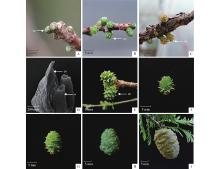
Fig.1
Development process of ovulate strobilus in T. mucronatum A: Ovulate strobilus in early January, bracts tightly packed together; B: Ovulate strobilus in late January, apical ovuliferous scales spread; C: Ovulate strobilus in early February, ovuliferous scales are all spread out and the emergence of pollination drops; D: Photograph of ovuliferous scales and ovules by scanning electron microscopy; E: Ovulate strobilus in mid-March with ovuliferous scales thickened and bent backward; F: Ovulate strobilus in mid-April, the base of adjacent ovuliferous scales begins to heal; G: Ovulatestrobilus in mid-May, the gaps between ovuliferous scales are completely filled with granular tissue; H: Ovulate cone in mid-June, ovuliferous scale flat with base cuneate and apex acute; I: Ovulate cone in mid-August, ovulate cone becomes tawny and completely lignified and slightly dehiscent. oc: Ovulate strobilus; os: Ovuliferous scale; o: Ovule."

Table 1
External morphological changes and internal features in the development process of ovulate strobilus of T. mucronatum"
| 时间Time | 外部形态External morphology of ovulate cone | 内部发育特征Internal features of ovulate cone |
| 1月初Early January | 苞鳞紧包,外部数层苞鳞红褐色Bracts tightly packed together and the outer bracts reddish brown | 珠心原基分化期 Division of nucellar primordia |
| 2月初Early February | 苞鳞展开,胚珠分泌出传粉滴 Ovuliferous scales are all spread out and the ovules secrete pollination drops | 珠心和珠被形成期 Formation of nucellus and integument |
| 2月中旬Mid-February | 传粉滴收缩,花粉进入胚珠内 Pollen grains enter the ovule along with the pollination drop withdrawal | 孢原细胞形成期 Formation of archesporial cell |
| 3月中旬Mid-March | 苞鳞增厚、向后弯曲 Ovuliferous scale thickened and bent backward | 大孢子母细胞形成期 Formation of megaspore mother cell |
| 3月下旬—5月上旬 Late March—early May | 大孢子叶球近球形,相邻苞鳞基部合生Ovulate strobilus becomes subglobose, and the adjacent ovuliferous scales connate basally | 雌配子体游离核分裂期 Division of free nucleis of megagametophyte |
| 5月中旬Mid-May | 苞鳞间的缝隙被颗粒状组织完全填充 The gaps between ovuliferous scales are completely filled with granular tissue | 雌配子体游离核细胞壁形成期 Cell wall formation of free nucleis of female gametophyte |
| 6月中旬Mid-June | 大孢子叶球卵圆形,并开始木质化,苞鳞扁平,基部楔形,先端尖 Cones are oval and begin to lignify. Ovuliferous scales flat with base cuneate and apex acute | 卵细胞成熟期和受精期 Mature egg cell and fertilization |
| 7月上旬Early July | 大孢子叶球外观与颜色无明显变化 Cones have no change in shape and color | 原胚发育期 Development of proembryony |
| 7月中旬Mid-July | 大孢子叶球颜色开始变为黄褐色,苞鳞先端枯萎或脱落 Cones color begin to turn yellowish brown, and the apex of ovuliferous scales begins to wither or fall off | 柱状胚发育期 Development of columnar embryo |
| 8月上旬Early August | 大孢子叶球完全木质化并轻度开裂 Cones become completely lignified and slightly dehiscent | 子叶胚初期 Initial cotyledon embryo |
| 9月中旬Mid-September | 外观无明显变化,种子成熟 Cones have no significant change in shape,mature seeds form inside | 胚成熟期 Formation of mature embryo |
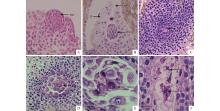
Fig.3
Male gametophyte development and megasporogenesis of T. mucronatum×T. distichum A: Primordium of ovule divides to produce a mass of nucellus; B: The differentiation of nucellus and integument of young ovule, and the formation of micropylar on the top of the nucellu; C: Archesporial cell in nucellus; D: Sporogenous cell in nucellus; E: Megaspore mother cell; F: The functional megaspore near chalazal and regressive megaspores near micropyle. nuc: Nucellus; it: Integument; mi: Micropylar; ac: Archesporial cell; spc: Sporogenous cell; mmc: Megaspore mother cell; fm: Functional megaspore; rm: Regressive megaspores."

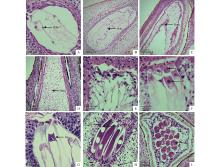
Fig.4
The female gametophyte development of T. mucronatum A: Early free nucleus of megagametophyte; B: Metaphase free nucleus of megagametophyte; C: Free nucleus division to thecenter and the formation of cell wall; D: Free nucleus are all cellularized and fill the female gametophyte; E: Archegonial initials;F: Central cell and primary neck cell; G: The newly formed egg cell and neck cell; H: The mature egg cell and jacket cells; I:The cross section of archegonium. fnm: Free nucleus of megagametophyte; ai: Archegonial initials; cc: Central cell; pnc: Primaryneck cell; nc: Neck cell; ec: Mature egg cells; jc: Jacket cells; ar: Archegonium."

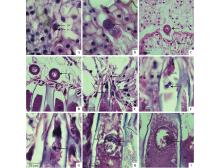
Fig.5
Fertilization of T. mucronatum×T. distichum A: Generative cell and tube cell; B: The enlarged spermatogenous cell; C: Pollen tube into female gametophyte; D: The pollen tube grows to the top of the archegonium; E: Sperm and other inclusions of pollen tube into the archegonium; F: The spermatogenous cell divided forming two equal sperm; G: Showing a sperm is entering egg nucleus; H: Nucleolus of sperm and egg fuse with each other; I: Zygote formed after fertilization. gc: Generative cell; tc: tube cell; sc: Spermatogenous cell; fg: Female gametophyte; nc: Neck cell; s: Sperm; pti: Inclusions of pollen tube; en: Egg nucleus; enu: Nucleolus of egg; sn: Nucleolus of sperm; z: Zygote."

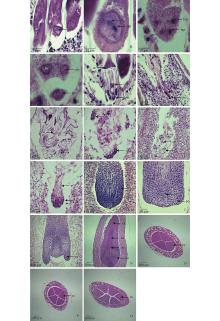
Fig.6
Embryonic development of Taxodium mucronatum×T. distichum A: Zygote migrates to the bottom of a archegonium; B: Proembryony with two nuclei by mitosis of the zygote; C: Proembryony with four nuclei; D: Proembryony arranges in two layers with eight nuclei; E: Upper cells, suspensor cells and proembryony cells of proembryony; F: Proembryony in the interior of female gametophyte and the elongation of suspensor cells; G: The suspensor system with multiple folds; H: Simple polyembryony; I: Cleaved polyembryony; J: Baculiform early embryo; K: Cylindrical embryo; L: Procambia and primordium of cotyledon; M: Late embryo after cotyledons diferentiated; N: Root apex, embryonal axis, cotyledon and shoot apex of mature embryo; O: Cross section of mature embryo with four cotyledons; P: Cross section of mature embryo with five cotyledons; Q: Cross section of mature embryo with six cotyledons. z: Zygote; fnp : Free nucleus of proembryony; otc : Cells of open tier; uc: Upper cells; sc: Suspensor cells; prc: Proembryony cells;ss: Suspensor system;sp: Simple polyembryony;cp: Cleaved polyembryony; s: Suspensor tier; be: Baculiform embryo; ce: Cylindrical embryo; rgm: Root generative meristem; pr: Procambia; pc: Primordium of cotyledon; co: Cotyledon; ra: Root apex; ea: Embryonal axis; sa: Shoot apex."

| 陈祖铿, 王伏雄 白豆杉的配子体发育和受精作用. 植物学报, 1979, 21 (1): 19- 31. | |
| Chen Z K, Wang F X The cametophytes and fertilization in Pseudotaxus . Acta Botanica Sinica, 1979, 21 (1): 19- 31. | |
|
胡玉熹, 林金星, 王献溥, 等 中国特有植物台湾杉的生物学特性及其保护. 生物多样性, 1995, 3 (4): 206- 212.
doi: 10.3321/j.issn:1005-0094.1995.04.004 |
|
|
Hu Y X, Lin J X, Wang X P, et al The biology and conservation of Taiwania cryptomerioides . Chinese Biodiversity, 1995, 3 (4): 206- 212.
doi: 10.3321/j.issn:1005-0094.1995.04.004 |
|
|
姜 蓓, 唐 亮, 路兆庚, 等 杉木大孢子叶球发育过程中形态结构的变化. 植物科学学报, 2017, 35 (4): 469- 476.
doi: 10.11913/PSJ.2095-0837.2017.40469 |
|
|
Jiang B, Tang L, Lu Z G, et al Morphological and structural changes during female cone development in Cunninghamia lanceolata . Plant Science Journal, 2017, 35 (4): 469- 476.
doi: 10.11913/PSJ.2095-0837.2017.40469 |
|
| 蒋 恕, 叶建国 杉木×柳杉胚胎发育的研究. 南京林学院学报, 1984, 1, 124- 130. | |
| Jiang S, Ye J G A study of the embryological development of Chinese fir × Cryptomeria. Journal of Nanjing Institute of Forestry, 1984, 1, 124- 130. | |
|
李春香, 杨 群 杉科、柏科的系统发生关系研究进展. 生命科学研究, 2002, 6 (1): 56- 60.
doi: 10.16605/j.cnki.1007-7847.2002.s1.013 |
|
|
Li C X, Yang Q Phylogenetic relationships among the genera of Taxodiaceae and Cupressaceae. Life Science Research, 2002, 6 (1): 56- 60.
doi: 10.16605/j.cnki.1007-7847.2002.s1.013 |
|
|
李卫星, 崔 慧, 何青松, 等 裸子植物种子发育过程及基因调控研究进展. 种子, 2016, 35 (6): 50- 56.
doi: 10.16590/j.cnki.1001-4705.2016.06.050 |
|
|
Li W X, Cui H, He Q S, et al The research progress of development and gene regulation of gymnosperm seeds. Seed, 2016, 35 (6): 50- 56.
doi: 10.16590/j.cnki.1001-4705.2016.06.050 |
|
|
田成玉, 赵春建, 李春英, 等 樟子松大孢子的发生和雌配子体的形成过程. 植物研究, 2006, 26 (6): 672- 675.
doi: 10.3969/j.issn.1673-5102.2006.06.008 |
|
|
Tian C Y, Zhao C J, Li C Y, et al The emergence of macrospore and the formation of female gametophyte in Pinus sylvestris var. mongolic . Bulletin of Botanical Research, 2006, 26 (6): 672- 675.
doi: 10.3969/j.issn.1673-5102.2006.06.008 |
|
| 王培蒂, 秦国峰. 1990. 马尾松胚胎发育的观察研究. 林业科学研究, 3(5): 441−447. | |
| Wang B D, Qin G F. 1990. Observation on embryo development of Masson pine. Forest Research, 3(5): 441−447. [in Chinese] | |
|
王 頔, 王 莉 颈卵器植物颈细胞结构与功能的研究进展. 西北植物学报, 2014, 34 (5): 1067- 1074.
doi: 10.7606/j.issn.1000-4025.2014.05.1067 |
|
|
Wang D, Wang L Structure and function of neck cells in archegoniate. Acta Botanica Boreali-Occidentalia Sinica, 2014, 34 (5): 1067- 1074.
doi: 10.7606/j.issn.1000-4025.2014.05.1067 |
|
| 王伏雄 落羽杉科的初期胚胎发育. 植物学报, 1953, 2 (3): 409- 414. | |
| Wang F X Embryogeny of Taxodium (Taxodiaceae) . Acta Botanica Sinica, 1953, 2 (3): 409- 414. | |
| 王伏雄, 钱南芬 水杉的胚胎发育. 植物学报, 1964, 12 (3): 241- 262. | |
| Wang F X, Qian N F Embryogeny of Metasequoia . Acta Botanica Sinica, 1964, 12 (3): 241- 262. | |
| 汪企明, 江泽平, 吕祥生, 等. 1995. 落羽杉属种源研究: 树种生物学特性. 江苏林业科技, 22(2): 14−18. | |
| Wang Q M, Jiang Z P, Lv X S, et al. 1995. Studies on the variation of provenances and families in genus Taxodium: introduction to the genus. Journal of Jiangsu Forestry Science & Technology, 22(2): 14−18. [in Chinese] | |
| 王紫阳, 徐建华, 殷云龙, 等. 2022. 落羽杉属新品种‘中山杉111’和‘中山杉125’. 南京林业大学学报(自然科学版), 46(2): 243−244. | |
| Wang Z Y, Xu J H, Yin Y L, et al. 2022. New cultivars of Taxodium ‘Zhongshanshan 111’ and ‘Zhongshanshan 125’. Nanjing Forestry University (Natural Science Edition), 46(2): 243−244. [in Chinese] | |
| 吴国芳, 冯志坚, 马炜梁, 等. 1992. 植物学. 北京: 高等教育出版社. | |
| Wu G F, Feng Z J, Ma W L, et al. 1992. Botany. Beijing: Higher Education Press. [in Chinese] | |
|
肖玉菲, 梁文斌, 徐刚标, 等 红豆杉属植物胚胎发育研究进展. 中南林业科技大学学报, 2013, 33 (10): 89- 94.
doi: 10.3969/j.issn.1673-923X.2013.10.019 |
|
|
Xiao Y F, Liang W B, Xu G B, et al Research progress in reproductive biology of Taxus . Journal of Central South University of Forestry & Technology, 2013, 33 (10): 89- 94.
doi: 10.3969/j.issn.1673-923X.2013.10.019 |
|
| 许道芬. 1984. 池杉有性生殖过程的研究. 林业科学, 20(4): 415−419. | |
| Xu D F. 1984. A study on the sexual reproduction of Taxodium ascendens Brongn. Scientia Silvae Sinicae, 20(4): 415−419. [in Chinese] | |
| 徐刚标, 刘雄盛, 梁文斌 极度濒危植物水松大孢子发生、雌配子体发育及胚形成. 林业科学, 2015a, 51 (6): 50- 62. | |
| Xu G B, Liu X S, Liang W B Megasporogenesis, female gametophyte development and embryogenesis in critically endangered Glyptostrobus pensilis . Scientia Silvae Sinicae, 2015a, 51 (6): 50- 62. | |
| 徐刚标, 肖玉菲, 刘雄盛, 等 濒危植物南方红豆杉大孢子发生和雌配子体发育. 植物科学学报, 2015b, 33 (3): 271- 280. | |
| Xu G B, Xiao Y F, Liu X S, et al Studies on megasporogenesis and development of megagametophytes in Taxus chmensis var. mairei . Plant Science Journal, 2015b, 33 (3): 271- 280. | |
|
徐明堂, 何春年, 张秀智, 等 苏木精染液的配制及染色方法的改进. 临床与实验病理学杂志, 2008, 24 (3): 371- 372.
doi: 10.3969/j.issn.1001-7399.2008.03.031 |
|
|
Xu M T, He C N, Zhang X Z, et al Improvement of the preparation and staining of hematoxylin stain. Journal of Clinical and Experimental Pathology, 2008, 24 (3): 371- 372.
doi: 10.3969/j.issn.1001-7399.2008.03.031 |
|
| 殷云龙, 於朝广. 2005. 中山杉. 北京: 中国林业出版社. | |
| Yin, Y L, Yu C G. 2005. Taxodium ‘zhongshanshan’. Beijing: China Forestry Press. [in Chinese] | |
|
殷云龙, 於朝广, 华建峰 ‘中山杉’ 的选育和利用及相关研究进展. 植物资源与环境学报, 2019, 28 (4): 99- 106.
doi: 10.3969/j.issn.1674-7895.2019.04.11 |
|
|
Yin Y L, Yu C G, Hua J F Breeding, utilization and related research progress of Taxodium ‘Zhongshanshan’ . Journal of Plant Resources and Environment, 2019, 28 (4): 99- 106.
doi: 10.3969/j.issn.1674-7895.2019.04.11 |
|
| 於朝广, 徐建华, 殷云龙. 2016. 落羽杉新品种‘中山杉503’和‘中山杉703’. 林业科学, 52(12): 156. | |
| Yu C G, Xu J H, Yin Y L. 2016. New varieties of Taxodium ‘Zhongshanshan 503’ and ‘Zhongshanshan 703’. Scientia Silvae Sinicae, 52(12): 156. [in Chinese] | |
| 於朝广, 殷云龙. 2010. 落羽杉属杂交良种‘中山杉302’和‘中山杉118’. 林业科学, 46(5): 181−182. | |
| Yu C G, Yin, Y L. 2010. Elite varieties of Taxodium hybrids ‘Zhongshanshan 302’ and ‘Zhongshanshan 118’. Scientia Silvae Sinicae, 46(5): 181−182. [in Chinese] | |
| 俞晓敏, 赵桂仿. 2004. 太白红杉雌配子体的形成、受精、胚胎发育及其系统学意义. 西北植物学报, 24(6): 1024−1034. | |
| Yu X M, Zhao G F. 2004. Female gametogeny, fertilization, embryogeny of Larix chinensis and it’s systematic significance. Acta Botanica Boreali-Occidentalia Sinica, 24(6): 1024−1034. [in Chinese] | |
| 于永福 杉科植物的分类学研究. 植物研究, 1994, 14 (4): 369- 384. | |
| Yu Y F Taxonomic studies on the family Taxodiaceae. Bulletin of Botanical Research, 1994, 14 (4): 369- 384. | |
| 于永福, 傅立国 杉科植物的系统发育分析. 植物分类学报, 1996, 34 (2): 124- 141. | |
| Yu Y F, Fu L G Phylogenetic analysis of the family Taxodiaceae. Acta Phytotaxonomica Sinica, 1996, 34 (2): 124- 141. | |
|
张 敏, 张 唯, 宫再欣, 等 油松大孢子叶球发生发育的形态与解剖学观察. 北京林业大学学报, 2017, 39 (6): 1- 12.
doi: 10.13332/j.1000-1522.20160411 |
|
|
Zhang M, Zhang W, Gong Z X, et al Morphologic and anatomical observations in the process of ovulate strobilus generation and development in Pinus tabuliformis . Journal of Beijing Forestry University, 2017, 39 (6): 1- 12.
doi: 10.13332/j.1000-1522.20160411 |
|
| 张 炎, 左丹丹, 陈 宇, 等 杉木胚珠的解剖学观察. 森林与环境学报, 2017, 37 (2): 142- 147. | |
| Zhang Y, Zuo D D, Chen Y, et al Anatomical observation of ovule of Cunninghamia lanceolata . Journal of Forest and Environment, 2017, 37 (2): 142- 147. | |
|
Coker W C On the gametophytes and embryo of Taxodium . Botanical Gazette, 1903, 36 (1): 1- 27.
doi: 10.1086/328373 |
|
| Duan H, Guo J, Xuan L, et al Comparative chloroplast genomics of the genus Taxodium . BMC Genomics, 2020, 21 (114): 1- 14. | |
| Hosoo Y Development of pollen and female gametophytes in Cryptomeria japonica . International Journal of Plant Developmental Biology, 2007, 1 (1): 116- 121. | |
| Jagel A, Dörken V M Morphology and morphogenesis of the seed cones of the Cupressaceae—part I Cunninghamioideae, Athrotaxioideae, Taiwanioideae, Sequoioideae, Taxodioideae. Bulletin CCP, 2014, 3 (3): 117- 136. | |
| Lickey E B, Walker G L Population genetic structure of baldcypress (Taxodium distichum [L.] Rich. var. distichum) and pondcypress (T. distichum var. imbricarium [Nuttall] Croom): biogeographic and taxonomic implications . Southeastern Naturalist, 2002, 1 (2): 131- 148. | |
|
Takaso T, Tomlinson P B Cone and ovule ontogeny in Taxodium and Glyptostrobus (Taxodiaceae - Coniferales) . American Journal of Botany, 1990, 77 (9): 1209- 1221.
doi: 10.1002/j.1537-2197.1990.tb13620.x |
|
| Tiwari S P, Yadav D, Kumar P, et al. 2012. Comparative palynology and wood anatomy of Taxodium distichum (L.) Rich. and Taxodium mucronatum Ten. Plant Systematics & Evolution, 298: 723−730. | |
| Wang Z Y, Yin M, Creech D L, et al Microsporogenesis, pollen ornamentation, viability of stored Taxodium distichum var . distichum pollen and its feasibility for cross breeding. Forests, 2022, 13 (5): 694. |
| [1] | Zhihua Yang,Xuemei Chen,Chunhua Chen,Limiao Zhang,Zhi Dong,Xue Tan,Changxiao Li. Characteristics of Taxodinm distichum var. imbricatum Seed Coat and Their Effects on Seed Dormancy [J]. Scientia Silvae Sinicae, 2022, 58(4): 11-21. |
| [2] | Tiantian Pan,Yan Li,Zhongyuan Wang,Shitong Lu,Linfeng Ye,Sen Chen,Jiangbo Xie. Relationship between the Hydraulic Function and the Anatomical Structure of Branch and Root Xylem in Three Taxodiaceae Species in Humid Area [J]. Scientia Silvae Sinicae, 2020, 56(12): 49-59. |
| [3] | Chen Xiangbo, Liu Yang, Zhao Mingshui, Tu Shuping. Embryo Development and Dormancy Releasing of Acer yangjuechi, the Extremely Endangered Plant [J]. Scientia Silvae Sinicae, 2017, 53(4): 65-73. |
| [4] | Xu Gangbiao, Liu Xiongsheng, Liang Wenbin. Megasporogenesis, Female Gametophyte Development and Embryogenesis in Critically Endangered Glyptostrobus pensilis [J]. Scientia Silvae Sinicae, 2015, 51(6): 50-62. |
| [5] | Lin Shuyan, Ding Yulong. Observations on Megasporogenesis, Microsporogenesis and Development of the Male and Female Gametophytes of Arundinaria simonii f. heterophylla [J]. Scientia Silvae Sinicae, 2013, 49(8): 168-175. |
| [6] | Yang Ling;Shen Hailong. Cytological and Histological Investigations on Somatic and Zygotic Embryogenesis of Sorbus pohuashanensis [J]. Scientia Silvae Sinicae, 2011, 47(10): 63-69. |
| [7] | Lin Xinchun;Yuan Xiaoliang;Lin Rao;Lou Yongfeng;Fang Wei. Megasporogenesis and Female Gametophytes Development of Phyllostachys violascens [J]. Scientia Silvae Sinicae, 2010, 46(5): 55-57. |
| [8] | Liu Yajuan;Su Junxia;Du Xiuli;Zhang Peng;Wei Xuezhi. Megasporogenesis, Microsporogenesis and Development of Gametophytes of Elaeagnus mollis [J]. Scientia Silvae Sinicae, 2008, 44(12): 39-42. |
| [9] | Li Guoping;Huang Qunce. Ontogeny of Pollen and Pollination in Keteleeria fortunei [J]. Scientia Silvae Sinicae, 2006, 42(5): 42-47. |
| [10] | Zhang Xueying;Peng Shiqi;Guo Zhenhuai. Studies on the Pollination, Fertilization and Embryo Development of Chinese Date `Wu_He_Zao' (Ziziphus jujuba) [J]. Scientia Silvae Sinicae, 2004, 40(5): 210-212. |
| Viewed | ||||||
|
Full text |
|
|||||
|
Abstract |
|
|||||